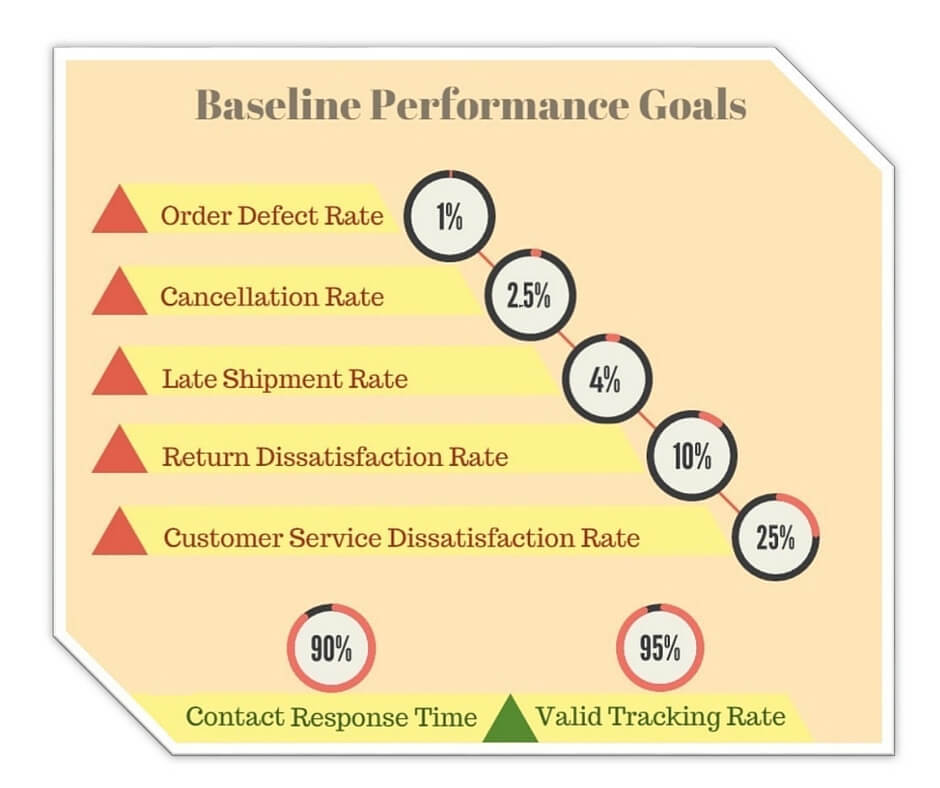What do you do when Amazon suspends your account citing a performance issue? We take a closer look at some of the main reasons for account suspension, and bring you tangible solutions to improve your Amazon performance metrics.
Read below to find out how to tackle some of the greatest Amazon performance issues.
Performance Metrics are criteria set in place for third-party sellers so that Amazon can tell the good ones from the bad. They’re also an incentive for sellers to excel in what they do, especially since Amazon’s mandatory targets keep growing in number and complexity.

This diagram shows you Amazon’s current thresholds for performance metrics. The ones in red carry a maximum limit, while those with minimum expected levels are green.
ODR, Cancellation Rate and Late Shipment are the main suspension criteria. A valid tracking rate of over 95% will soon add to the list, as you may have read in a previous blog post.
Contact Response Time results of 90% or above are not essential, but they may sway the balance in your favor when Amazon reviews your account.
Finally, Return and Customer Service Dissatisfaction Rate (RDR and CSDR) levels are not currently mandatory, but may be in the future.
HOW TO DEAL WITH A SUSPENSION
Before you submit your letter of appeal, you should try to fix the metrics Amazon mentioned in the suspension email. Then, you should focus on finding tangible long-term solutions.
1. Address Your ODR
The Order Defect Rate is your best reference point when Amazon signals an issue with your account. An Order Defect Rate that’s above 1% is considered high, but for your account to have been suspended, your ODR probably rose above 1.19%.
Before you focus your efforts on the most relevant ODR issues, you should know that A-to-Z claims continue to affect your ODR even after they’re retracted. Also, chargeback claims need to be settled with the banks in question, even if they don’t affect you ODR.
Here’s what you can do to improve ODR before you appeal:
- Try to persuade the customers or Amazon to remove negative feedbackA performance rating on a scale of 1 to ... More.
- Ask your suppliers to send replacements promptly to prevent or offset A-to-Z claims and negative feedback.
Here are some long-term solutions you could implement and mention in your appeal:
- Refer to specific complaints and reviews, and offer better wrapping, stricter quality control, improvements in transportation, or a change of supplier, as needed.
- Supplement your team in charge of conditionProducts can only be listed on Amazon if... More checking, shipment processing, etc.
- Come up with a way to keep an eye on feedback or buy an application that can do that for you.
- Figure out a safer performance monitoring system to realize you’re reaching a threshold long before you actually do.
2. Work on Cancellation and Late Shipment Rates
Warnings and account terminations due to order cancellation and late shipments indicate that you’ve run out of stock or mismanaged your shipping and confirmation processes. Cancellation rate includes only orders initiated by you, not those where buyers use the order cancellation feature in their Amazon account. As for Late Shipment Rate, delaying shipping or forgetting to confirm a shipment by the expected ship date is bound to increase this metric.
Here are some of the things you can do before you appeal:
- Revise your handling time if the standard one isn’t enough.
- Check your recent records to see if your couriers are prompt with their collections and deliveries.
- Determine the time it takes you to confirm a shipment on Amazon, on average, and suggest ways to shorten that time, either by speeding up shipments or by tweaking your internal procedures.
Your letter of appeal can mention the following solutions and long-term plans:
- Trying to boost sales to bring down the overall cancellation and late shipment rates.
- Switching suppliers or changing your business model altogether if you can’t comply.
- Making sure that you switch to Holiday mode when you can’t fulfil orders for several days.
- Hiring more packers, handlers and shippers.
- Using more responsive inventory management software.
- Implementing measures to help your support staff monitor these parameters more efficiently.
HOW TO KEEP YOUR METRICS IN CHECK
There are also a few other or more general steps you could take to make sure your metrics are always in line with what Amazon expects:
A. Aim for Perfection. If you sell certain SKUs repeatedly, make sure you monitor your Imperfect Orders Report regularly to identify patterns and even spot items that customers seem to always expect a refund for.
B. Be Proactive. Keep an eye on customer complaints, negative feedback, poor reviews, return requests, and all the information you can find in your Seller Communications Center and your products’ detail pages to get to the bottom of what went wrong. Set yourself harder goals than Amazon’s metrics, work out ways to set off an internal alarm whenever you fall behind, and be prepared to act as soon as you reach or come close to a threshold, like discontinuing faulty stock, for instance.
C. Keep Customers Happy. To improve Return and Customer Service Dissatisfaction Rates:
- State your return policy clearly.
- Authorize returns, issue refunds or close return requests within 48 hours from the moment they’re received.
- Whenever you reject a return request, make sure you are completely justified in doing so.
- Learn from experience, and try different approaches in your replies. Pinpoint your most likely sources of negative votes and tweak your reply templates for these customers..
We hope our suggestions have given you some food for thought, but it you’d like to know more about the reasons Amazon accounts are suspended, and what can be done to cope with and challenge a suspension, please stay tuned for our next blog in the series. Part 3 will address the issue of selling items that don’t comply with current condition guidelines.







